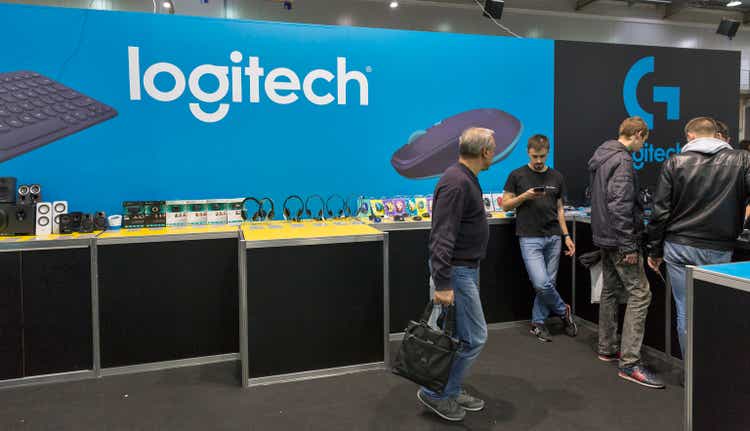Imagine you’re the CEO of a small Silicon Valley company that sells a compelling little device. It’s a next-generation communicator, the size of a wad of gum, that fits snugly over the user’s back tooth.
The “Molar Mic” captures the voice with high fidelity, even in surroundings of extreme noise, and wirelessly transmits audio signals to the wearer by vibrating the nerves of the inner ear. It makes the Airpod-to-iPhone interface look like tin cans on a string, and you can just imagine how valuable it might be to, say, a commando in a firefight. It’s the kind of gadget the tech genius “Q” would hand to James Bond before he goes out on a mission—except that it’s totally real.
Normally, you’d be thrilled if Fortune called you up with a chance to tell the world about it. But there’s one, huge problem: Because real-life national-security types are your ideal customers for the Molar Mic—indeed, may already be buying it—you’re forbidden from talking about it very much at all
“I can’t,” Peter Hadrovic, the company’s CEO, tells me. “ I know it seems weird that I’ve got all this publicity here I’m walking away from, but.
Hadrovic’s company is called Integrated Tactical Technologies. On its website, the company goes by the acronym “iT2,” an aptly opaque choice for a business that’s the opposite of public-facing.
There’s a fraught pause. Hadrovic looks off into the low middle distance. He’s 6’9” and still built like a skinny center, the tall-man position he played on Princeton’s basketball team. “Can’t talk about it,” he says, breaking into an apologetic smile. “I’m not selling it to anybody who I can say I’m selling it to.”
He’s not saying he’s selling it to real-life James Bonds. But he’s not not saying that, either. And he didn’t turn down the interview outright, because he very much wants to say nice things about a stealthy venture capital fund called In-Q-Tel, whose 2009 investment made building the device possible.
“There’s no way the Molar Mic exists, but for In-Q-Tel,” Hadrovic says.
In-Q-Tel was founded in 1999 by the CIA—yes that CIA, the Central Intelligence Agency—with the mission of closing a perceived innovation gap between Washington’s security establishment and Silicon Valley. Inventions like the Molar Mic are the reason In-Q-Tel exists. Over its 26 years in business, the fund has helped launch more than 800 companies. Of the companies in this year’s NatSec 100 Report, an annual index of the fastest-growing venture-backed defense startups, In-Q-Tel is an investor in 32—far more than any other fund.
Some of the companies the fund backs are publicly known, others are secret—as is the total amount of money In-Q-Tel has invested since it began. (Fortune’s estimate, informed by the last 25 years of In-Q-Tel’s tax disclosures, is at least $1.8 billion and likely more. But In-Q-tel itself, and sources close to it, declined to share or discuss any numbers.) Whatever the amount, by and large, the companies In-Q-Tel picks are all building technologies judged to be vital for U.S. national security.
 Helicopters on a rescue mission outside Houston after Hurricane Harvey in September of 2017. The Molar Mic helped rescuers communicate over helicopter engine noise.
Helicopters on a rescue mission outside Houston after Hurricane Harvey in September of 2017. The Molar Mic helped rescuers communicate over helicopter engine noise.What’s more, when it finds a winner, more traditional venture investors often follow its lead. Some of In-Q-Tel’s picks have grown to become big players in their own right. Early on, the fund backed the autonomous weapons maker Anduril, which was last valued at $14 billion. In-Q-Tel also backed Palantir, supplier of big data analytics to the military and intel agencies. Palantir may well be the clearest sign that Silicon Valley has shacked up with the Pentagon for good: It was recently valued at $250 billion, surpassing traditional defense contracting titans like Northrup Grumman, Lockheed Martin and General Dynamics, even though its revenue, at under $3 billion last year, is just a fraction of those giants’.
It’s possible, even likely, that you have one of In-Q-Tel’s biggest successes installed on your phone now. In 2003, In-Q-Tel invested in a mapping company called Keyhole, that was looking to build a tool for the Pentagon’s National Imagery and Mapping Agency. Within weeks, according to In-Q-Tel, the agency had put Keyhole’s technology to work supporting U.S. troops in Iraq. Two years and one acquisition later, a new, commercial version of the product launched. The new owner called it Google Earth.
Organizationally, In-Q-Tel is an odd duck. It’s an independent venture capital fund, but it contracts exclusively with the federal government. Tax records show that it’s sitting on roughly $1 billion in assets, but it operates as a non-profit. The Virginia-based fund’s nearly 200 employees are charged with finding and funding companies whose technology could help the U.S. intelligence community or Defense Department. In-Q-Tel currently receives around $100 million in additional taxpayer money per year to invest. It puts the companies it picks in touch with end users inside the government to refine their products, all in hope of yielding tech that’s both commercially successful and useful to people protecting U.S. national security.
In a moment when defense tech has suddenly become a hot enough commodity that venture capitalists are venturing to Washington in force, In-Q-Tel is something of an elder statesman. It stands as a quiet corrective to the idea that Elon Musk’s Department of Government Efficiency was the first time start-up-style disruption touched the federal government. For 25 years, In-Q-Tel has been teaching the Pentagon how to fail fast and be agile.
“It’d be great for them to get credit for the consistency of the work they’ve been doing when this stuff was not a fad,” says Paul Kwan, a managing director at General Catalyst, a venture fund with $32 billion under management that has backed Airbnb, Stripe, and Instacart. On several occasions, General Catalyst has taken note of In-Q-Tel’s early picks and co-invested. That’s not unusual. In-Q-Tel has said that, for every dollar it invests in a company, commercial VCs can usually be counted on to invest around $40 more.
Kwan says this halo effect in part grows out of the cadre of experts that In-Q-Tel keeps on staff. Unlike traditional VCs, they subject candidate companies to intense, in-house technical vetting before funding them. “It is a giant proctology exam, but it’s worth it to get that stamp of approval,” he says.
In 2004, a researcher at the Air Force Institute of Technology interviewed CEOs of a dozen companies who’d received backing from In-Q-Tel. One of them described the vetting process as having “a bunch of PhD’s sitting in my office for two or three months asking questions that no commercial customer, even Fortune 500 customers, had asked us.” He also noted, “These people really get in your shorts.”
In-Q-Tel’s CEO, Steve Bowsher, has spent a decade and half working to keep that process going. He’ll be the first to celebrate the high-dollar, high-profile successes. “If we make money as part of that, that’s great,” he tells Fortune. “But that’s not the primary goal.”
The goal, Bowsher says, is what In-Q-Tel internally describes as “pilots and adoptions”: That is, testing startups’ tech with people inside the U.S. government and then seeing whether they permanently put it to work. Which is to say, unlike maybe every other investor across the landscape of capitalism, these investors are specifically not obsessing about whether their investments make money.
In a sense, In-Q-Tel measures success with benchmarks that are anything but financial. One is cultural: prodding the U.S. national security apparatus, and the companies that serve it, to change their sometimes-sluggish ways. The other is more personal, and felt keenly by anyone involved in national security: having the latest technological edge helps save American lives.
Inspired by James Bond movies
In 1998, it felt like the world had become digital, seemingly overnight. That year marked the founding of Google, the release of the iMac, and America Online’s purchase of Netscape for more than $4 billion. World-changing technology was coming out of California. Washington, D.C., was playing catch-up.
Among the security insiders taking notice was Sue Gordon, a career CIA officer who later rose to become the second-highest ranking intelligence official in the U.S. government. Gordon was the driving force who got In-Q-Tel up and running. (I interviewed her for a podcast in 2024, and again for this story in June.)
“Silicon Valley couldn’t find their way into the CIA and national security community because it’s tuned for the big guys in the defense industrial base,” Gordon told me last year. “We knew that the good stuff was happening in Silicon Valley. But…we needed to go outside to get access.” One solution, she felt, would be to set up an investment fund that would bridge those worlds—to jumpstart companies building cutting-edge spy tech, and then put that tech into the hands of the U.S. agencies that needed it most.
Gordon says she still has a napkin from the bar at the legendary Hay Adams Hotel in D.C., where she and a couple of fellow In-Q-Tel founders first brainstormed names for the organization. And yes: The “Q” was a deliberate reference to the Bond movies. “I insisted,” Gordon tells me. “All the stuff that Q would bring out was the coolest part of the movies.”
 Sue Gordon, deputy director of national security, at a congressional hearing in May 2018. Gordon was a key player in the founding of In-Q-Tel.
Sue Gordon, deputy director of national security, at a congressional hearing in May 2018. Gordon was a key player in the founding of In-Q-Tel. Gordon enlisted the help of Michael Crow, then an administrator at Columbia University, specializing in science policy. Crow, who’s now president of Arizona State University, is the chair of In-Q-Tel’s board. He says one of the biggest hurdles standing between In-Q-Tel and launch was the byzantine set of rules the U.S. government has for procuring defense equipment. Bureaucrats were initially allergic to In-Q-tel’s plans to pilot new tech quickly, and some legacy contractors felt threatened.
“It sort of blew up the whole notion of procurement,” Crow says. “Administrative-type people were like, ‘Well, we gotta kill this thing.’”
But In-Q-Tel survived the initial opposition, in part, by making itself indispensable. One key feature was a system that Bowsher put into place not long after he joined the fund as managing partner in 2006. Borrowing an idea from private equity firms where friends of his had worked, Bowsher trained a cadre of associates whose job was essentially what he calls “dialing for deals”—scouring magazines, newspapers, blogs and newsletters for promising companies, cold calling them, and set up meetings to learn about their business.
“It’s very easy just to look at all the business plans that someone proactively submits to you and feel like, ‘Hey, I’m looking at a lot of deals and right now I’m picking the best ones.’” Bowsher says. “You got to figure out, am I seeing quality deals here?”
He says In-Q-Tel now looks into around a thousand or so companies per year, with a roughly 50-50 split between makers of hardware and software. That work helps In-Q-Tel widen its aperture to see the broadest possible swath of new tech, Bowsher says. Just as importantly, it writes up its research on bleeding-edge start-ups—making itself useful to the intelligence community, even when it comes to companies in which it doesn’t invest.
“One director of science and technology at CIA said to us one time, ‘One of the value propositions of In-Q-Tel to me is: no surprises,’” Bowsher says. This official told Bowsher that whenever he’s told about technology that could affect the CIA’s mission, he’s consistently able to say, “‘I know about that technology. In-QTel briefed me on it six months ago.’”
Learning to fail fast
Bowsher is originally a son of Washington. His father spent most of his career in government—as a CPA running the U.S. Navy’s budget, and later as a comptroller general at the GAO, Congress’s auditing and investigative office. After getting a B.A. from Harvard, Bowsher headed west to attend Stanford Business School and stayed in Silicon Valley to work for several start-ups. The first one—attempting to launch multiplayer online video gaming in the dial-up era—crashed and burned.
“It’s a [multi-]billion-dollar industry right now, right? My son spends hours playing video games. We were just too early,” Bowsher says. “Those signs were all there and I missed them.”
He came into work one Friday morning to learn he’d been laid off, along with the entire marketing, business development and product team. He stepped out of the building, feeling stunned, clutching paperwork to file at the San Mateo County unemployment office.
“And honestly, I thought to myself, how am I going to call my parents—who paid for me to go to Harvard, you know, who helped me pay to go to Stanford?,” he says. “How am I going to go call and tell them I’m unemployed?”
Bowsher’s father suggested that he go into banking or consulting. But Bowsher’s contacts in Silicon Valley had a very different reaction. “My friends started emailing, ‘Hey, you should come work at Yahoo,’ ‘You should come work at Excite,’ ‘You should come work at this company or that company.’”
Bowsher says the moment demonstrated to him a core part of the Valley’s ethos: Failing fast is okay. Failure winnows out ill-conceived or ill-timed ideas, so founders can more quickly make way for better ideas. “People in D.C. just can’t get their heads around it,” Bowsher says. “Silicon Valley is all about: We’re going to fail as much as possible because the more times you fail, the closer you get to that extraordinary success,” he says.
It’s a very different model than the legacy Pentagon contracting framework, which brought U.S. taxpayers, say, the F-35 fighter jet. Plagued with early problems, that airframe has taken two decades to design and build, at a cost of $442 billion so far—which adjusted for inflation is twelve times more than the entire Manhattan Project.
 Yan Zheng, In-Q-Tel’s chief of staff.
Yan Zheng, In-Q-Tel’s chief of staff.Failing fast doesn’t necessarily spell the end for companies that In-Q-Tel backs. In-Q-Tel’s chief of staff, Yan Zheng, met with Fortune at the fund’s sleekly modern headquarters just outside of D.C. in Tysons, Va.. The office was all spotless steel, glass, and oak parquet, with nary a coffee cup out of place. Zheng was tie-less in a slim navy suit, looking like neither he nor his outfit were aware wrinkles exist. But he leaned forward in his seat, smiling, as he told a story about an epic mess.
It involved Alteros, an In-Q-Tel startup that made a blimp-based communications antenna. Aerostats, as they’re known, are a great way to set up powerful comms towers in remote areas. They normally require a 24/7 human crew to monitor weather conditions and keep the balloon aloft. But Alteros made a version that deploys and flies autonomously—which caught the interest of some folks inside the U.S. government, at an agency whose identity can’t be disclosed.
“These folks were spending multiple millions of dollars to field a less capable system,” Zheng says. “ Folks really were like, this is going to be a good solution. It was going to save money.”
But then came the demonstration flight. At an old mining site five hours outside of Boston, observers from In-Q-Tel and the government agency watched the Alteros technicians send their blimp aloft.
“And then the whole thing just ripped apart. And it just went—psshh.” Zheng says. “Everyone was, like, deflated.”
It looked like the company’s deal with the government could be dead. But Alteros proved willing to keep spending money to refine the design. And here’s when another unusual aspect of In-Q-Tel’s business model came into play. The secret government customer stepped in to help—suggesting that instead of Alteros trying to make everything itself, it ought to consider buying stronger blimp fabric from one of the two vendors used by the U.S. military.
“They did, and it worked,” Zheng says “And that was because they were good about taking that feedback from that government partner.”
This working relationship that In-Q-Tel sets up between start-ups and people on secret branches of the U.S. government org chart is another way the fund differs from commercial venture capital. Imagine, for example, that a small tech company wants to test a gadget they think would be a perfect fit for SEAL Team 6.
“SEAL Team Six is very busy. They are not going to be involved,” says AJ Bertone, a managing partner at In-Q-Tel who manages the fund’s West Coast team. “And so, our technologists and really everyone at In Q Tel, we’re translating between these two very disparate worlds, and helping to align the different technology and engineering decisions.”
“And then,” Berton added, “We’re going to be there when they’re actually putting it to work. Not necessarily like, in the Osama Bin Laden raid scenario, but in some type of test.”
To be clear, no one Fortune spoke with would confirm or deny that In-Q-Tel has worked with SEAL Team 6. (Take that however you’d like.)
But figuring out which specific government badasses are getting the tech matters less than understanding the importance of the bridge that In-Q-Tel builds between those badasses and the start-ups who’d like to serve them. This seems to be the heart of the argument In-Q-Tel makes for investing taxpayer money—your money—in private, for-profit companies.
Finding companies that Silicon Valley misses
In-Q-Tel says it solves problems that government and commercial venture capital handle poorly on their own. First, they’ve found lots of start-ups that are making game-changing tech but are too small to interest a VC industry built around hunting billion-dollar unicorns. And that’s where In-Q-Tel fills the gap.
In-Q-Tel wants companies that have an addressable commercial market outside of any potential government contract—but the market doesn’t need to be huge. “Are you in a market that, like, you’re not going to give a 10X ROI, or a 2X, but you’re still going to get a product to the government?,” Zheng asks. “That’s fine with us.”
Second, Zheng says, In-Q-Tel solves a problem that the government still struggles with. More than ever, the people protecting U.S. national security need cutting-edge technology. Sometimes big defense contracting “primes” can supply it. But history suggests technology’s edgiest edge is often being honed on the fringes of Silicon Valley. If you’re a bureaucrat in charge of government procurement, this poses a problem.
“You’re going to get two guys in a garage and you’re going to get a Raytheon coming in at you,” Zheng says. “And right now, you deal with them by saying,’Two guys in a garage, you can’t apply, we’re only dealing with primes.’That is the model that the government is [now] trying to fix.”
Traditionally the government operates on timelines measured in multiple years. For tiny new companies—focused on getting their next round of funding, or making payroll next month—it’s a hard system to plug into. In-Q-Tel bills itself as offering a pathway for small innovators to talk to the government. “We’re the translator, the translation layer,” Zheng says.
Bowsher says he’s confident that the Trump administration will see the value this translator offers, even as DOGE has taken a chainsaw to entire agencies. For the CEO of an organization doing hard-to-explain work with millions of taxpayer dollars, it’s a delicate moment.
Early-stage VCs are optimistic by nature, Bowsher says, and the optimist in him sees an opportunity in an administration that’s willing to move fast, break old rules and seek counsel from veterans of Silicon Valley. “There are a set of people coming in who we worked with in the first Trump administration that like us,” Bowsher says, “and believe in our model and believe that we can help.”
“I think the challenge or risk for us is, you know, there’s obviously a movement within this administration to cut costs and deliver efficiency,” he says. “You don’t want to get caught up in some sort of unintentional cut where someone cut you because they didn’t understand who you are and what your value proposition is.”
Bowsher’s not alone with his concern. “I can imagine DOGE coming in,” Gordon told me late last year, “and saying what the hell is that?”…What is this model? Who thought of it?”
In-Q-Tel doesn’t show up in the press often, but when it has, some outlets have pointed out that it doesn’t follow regular procurement rules, or that members of In-Q-Tel’s board in a few cases have had ties with companies In-Q-Tel has backed. Others mentioned that In-Q-Tel’s CEO, despite working for a non-profit, receives a salary of $2 million.
“That’s far less than the CEO of Northrup Grumman makes,” Gordon told me pointedly. “They don’t write the story of what exists because of it.”
‘They took it in combat, and they didn’t get shot’
For an example that proved Gordon’s point, I spoke with another promising-but-small company that says it wouldn’t have landed a defense contract without In-Q-Tel’s help. The company is similar to the maker of Molar Mic, in that the per-unit cost of the gadget it makes runs in excess of $5,000—likely excluding it from a big consumer market, and from big investment bucks from traditional venture capital.
The company is called Bounce Imaging, and it launched in 2012 with the idea of making a softball-sized device covered with cameras. Once tossed into a room, the ball could capture a real-time, omnidirectional video of the scene and send it to a user’s phone. For, say, a commando or SWAT team member preparing to storm into a room that might be full of hostages and a gunman, the appeal was obvious: Swipe around on the image, and it shows where the bad guy is.
“This is a really simple thing to explain, but it’s actually turned out to be an amazing technical challenge to pull off,” says Francisco Aguilar, Bounce Imaging’s CEO. The challenge was twofold: cramming the hardware and battery inside what is essentially a large rubber ball, and designing software that could stitch together all that lens data and stream it to a phone with minimal lag.

 Top: A demonstration of a commando using the Bounce Imaging remote camera device. Above: A close-up of the device.
Top: A demonstration of a commando using the Bounce Imaging remote camera device. Above: A close-up of the device.Early on, the company had around 10 employees and was doing about $1 million worth of business per year, Aguilar says. It was piloting versions of its device with 100 or so law enforcement agencies across the U.S. But progress was slow, and the main way forward seemed to be selling to more cops.
Then, in 2018, In-Q-Tel invested an undisclosed amount. After that, Bounce started working with partners in the Defense Department. Aguilar says the company has since tripled its staff, and is on track to do $15 million in business this year. “We’re about to do a major deployment with a NATO ally that is going to be millions of Euros,” he says.
The camera has become a go-to tool for Special Operations Command, Aguilar says, and the company expects to have close to 1,000 of their systems in DOD by the end of 2025. He can’t disclose which units are using them, but he can talk about some of the feedback he’s received.
“In any war,” he says, “you are inevitably in these situations where you are sending a person or a dog into a confined space to try to get someone out. And in those environments, casualties are common.”
As advanced as warfare has become, there are still people working for the U.S. government whose job is to run through a doorway first, knowing there’s a very real chance they’ll be shot when they do. Not every tactical squad has the space or budget to carry a robot. Bounce’s camera costs less, and fits in a pouch on someone’s gun belt.
But there’s no billion-dollar business to be found solving this problem. For a big commercial venture capital firm, the gains and costs here would hardly register on a balance sheet. And the true cost of work like this is only tallied by orphans and widows, when the flag-draped coffins come home.
So that’s where the U.S. taxpayer, In-Q-Tel and the maker of the ruggedized, throwable camera come in.
“I will tell you that there have been units that have taken casualties in specific scenarios on every rotation that stopped taking that type of casualty,” Aguilar says. “When they use our camera—we have been told by people who I trust who do this—that they have come out without that casualty.”
“They used it. They took it in combat,” he says. “And they didn’t get shot.”
This story was originally featured on Fortune.com

 11 hours ago
1
11 hours ago
1









 English (US) ·
English (US) ·